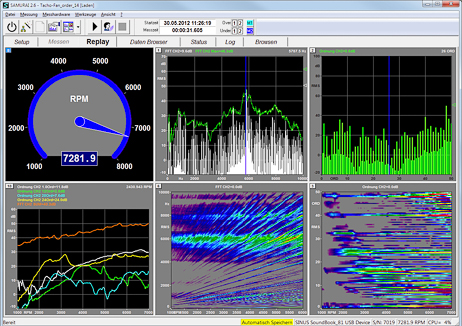Order-Tracking
SAMURAI™-Option
digital order analysis
measurements on rotating machines

Overview
Application
Order analysis is an established method for examining vibration processes and noise emissions in rotating machine or system parts. In contrast to a common FFT, the so-called order spectrum (levels of multiples or fractions of a base speed or rotation) is more interesting than the plain frequency spectrum. This can be used, for example, to localize gearbox damage.
Description
The SAMURAI™ Order Tracking option includes both order analysis using block-based FFT methods (fixed frequency) and digital order analysis using resampling.
Block-based FFT methodThis algorithm assumes a mainly constant speed. As the order resolution increases, longer FFT windows are necessary for the analysis. Since Fourier Transforms are subject to a so-called frequency-time uncertainty, this leads to a reduced time resolution. In the case of rapidly changing speeds, this leads to a spectral "smearing". The digital order analysis described below can be used for such cases.
The speed resolution of the FFT method is directly dependent on the sampling rate and the number of FFT bins.
Digital order tracking (resampling)The algorithm of the digital order analysis is more computationally intensive than the FFT method. Digital order tracking is better suited for both constant and variable speeds and is therefore used very often. To minimize the computational effort, it is recommended to restrict the analysis to the desired order area. The raw tachometer signal (bit trace) of the Apollo measuring devices is used to display rapid speed changes. This speed signal is many times more precise than the averaged speed signal that our software uses for the FFT method.
Furthermore, the algorithm is well suited for a high resolution of the order analysis. However, several rotations are necessary for this. This leads to uncertainty of the speed. Another advantage over the FFT method is that the individual orders stand out more clearly.
The digital order analysis is particularly recommended for the following applications:
- Recordings with rapid speed changes
- Analyzes with high order resolution
Figure 1:
Increase rotation speed of an engine: tachometer signal (“speedometer”), level recorder (orders), sonogram (orders), waterfall (orders), sonogram (FFT), waterfall (FFT)
Figure 2:
Increase rotation speed of a ventilator: tachometer signal, FFT spectrum, order spectrum, level recorder (orders), sonogram (FFT), sonogram (orders)
Feature
| Features |
|
Requirements
This software option requires a valid SAMURAI™-base license.


